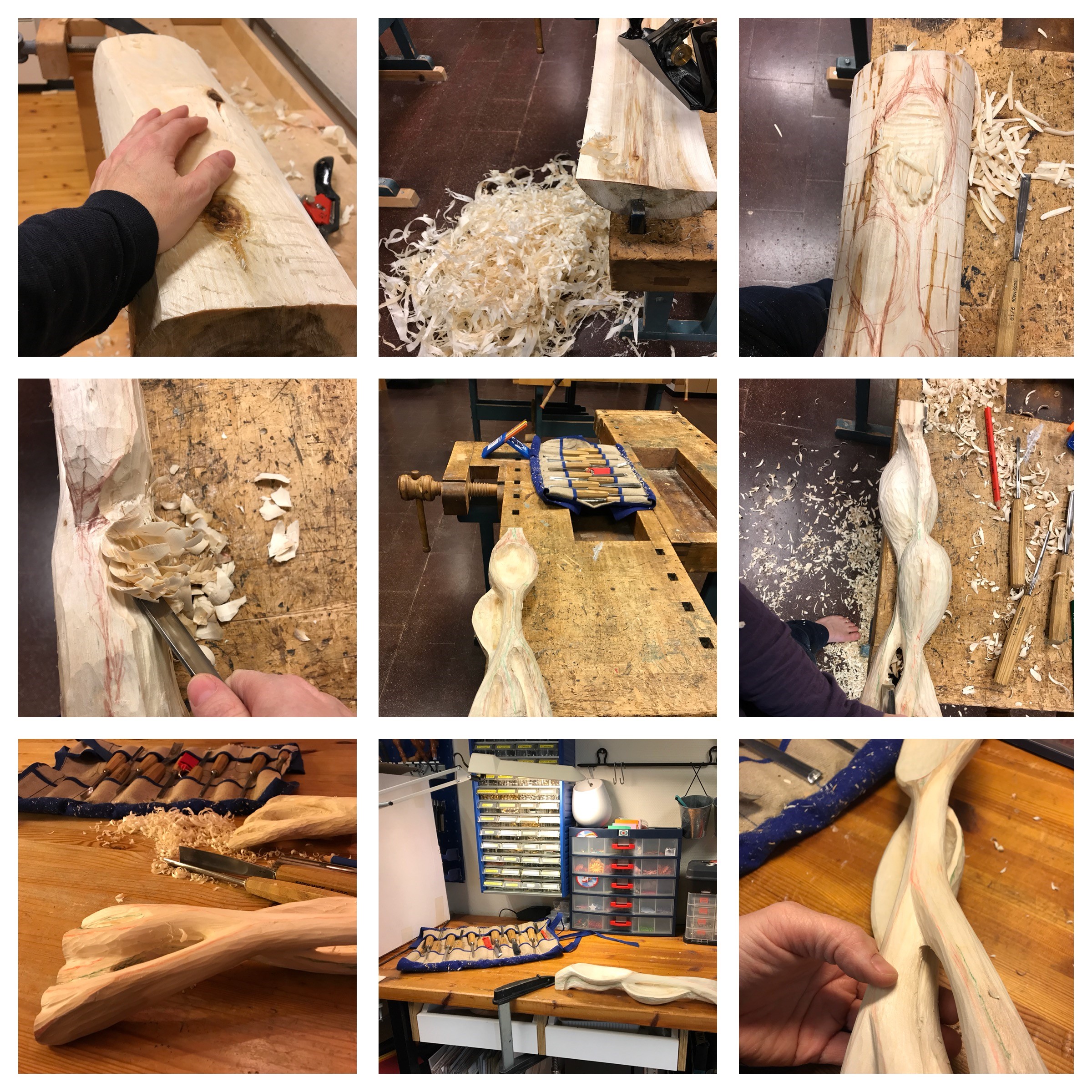What I learned by doing craft when I got terminal cancer
On woodcarving and psychophysical wellbeing from an insider perspective
DOI:
https://doi.org/10.7577/formakademisk.5378Emneord (Nøkkelord):
Treskjæring, Psykofysisk velvære, kreft, taktil kontakt, verdi og mening av håndverkSammendrag
In this paper I use theory on craft and psychophysical wellbeing to extract insights on the value and meaning I found in woodcarving after being diagnosed with terminal brain cancer. I continued to carve wood throughout the entire diagnosis and treatment period. I was already an experienced woodcarver and had done extensive research on my own making processes. Both the making and research provided meaning and value for me in my ordeal. I discuss three lessons I learned: 1) Deliberate controlling of attention on the here and now worked as a coping mechanism, giving meaning and value to my situation; 2) Grounding myself in physical touch with a close connection to the material contributed to maintaining my positive identity as both maker and researcher, and acted as another coping resource; and 3) As I made the objects, I re-made myself. My intention to save and finish these artifacts, and the joy I experienced as I finished them, gave meaning and purpose to my situation. These lessons support previous findings on craft and wellbeing, contribute insider insights on the use of wood in art making during cancer treatment, and they could potentially inspire others facing dire straits to use crafting to cope.
Referanser
Abra, J. (1995). Do the Muses dwell in Elysium? Death as a motive for creativity. Creativity Research Journal, 8, 205–217. https://doi.org/10.1207/s15326934crj0803_1
Alvesson, M., & Sköldberg, K. (2000). Reflexive methodology: new vistas for qualitative research. Sage.
Collier, A. F. (2011). The well-being of women who create with textiles: Implications for art therapy. Art Therapy, 28(3), 104–112. https://doi.org/10.1080/07421656.2011.597025
Csikszentmihalyi, M. (1996). Creativity: Flow and the psychology of discovery and invention. Harper Collins.
Denzin, N. K. (2014). Interpretive autoethnography - Second edition (Vol. 17). Sage. https://doi.org/10.4135/9781506374697
Ennis, G., Kirshbaum, M., & Waheed, N. (2018). The beneficial attributes of visual art‐making in cancer care: An integrative review. European Journal of Cancer Care, 27(1), e12663-n/a. https://doi.org/10.1111/ecc.12663
Groh, J. M. (2014). Making space: How the brain knows where things are. Harvard University Press. https://doi.org/10.2307/j.ctt9qdt4n
Gulliksen, M. (2001). The creative meeting – A discussion over the aesthetic elements in the creative process. In C. Nygren-Landgärds & J. Peltonen (Eds.), Techne Series, Visioner om Slöjd och slöjdpedagogik [Visions on sloyd and sloyd pedagogy. (Vol. B:10/2001; 55-64). NordFo/Åbo Universitet.
Gulliksen, M. S. (2020). Underlying the carver’s experience - Sensorimotor modulation in the cerebellum when carving wood. FormAkademisk, 13(3), 1–15. https://doi.org/10.7577/formakademisk.3581
Gulliksen, M. S. (2021). There and back again: A carver’s tale of losing and regaining sense of space due to a brain tumour. Craft Research, 12, 127–152. https://doi.org/10.1386/crre_00043_1
Huotilainen, M., Rankanen, M., Groth, C., Seitamaa-Hakkarainen, P., & Mäkelä, M. (2018). Why our brains love arts and crafts. FormAkademisk, 11(2), 1–18. https://doi.org/10.7577/formakademisk.1908
Jiang, X.-H., Chen, X.-J., Xie, Q.-Q., Feng, Y.-S., Chen, S., & Peng, J.-S. (2020). Effects of art therapy in cancer care: A systematic review and meta-analysis. European Journal of Cancer Care, 29(5), e13277. https://doi.org/10.1111/ecc.13277
McMillan, I. A. (2011). Wellbeing through woodwork. Mental Health Today, (September/October), 12-13.
Merleau-Ponty, M. (1962). Phenomenology of perception (C. Smith, Trans.). Routledge.
Ramón y Cajal, S. (1899). Drawing of Purkinje cells and granule cells from pigeon cerebellum [Drawing]. Instituto Cajal, Madrid, Spain.
Reynolds, F., & Lim, K. H. (2007a). Contribution of visual art-making to the subjective well-being of women living with cancer: A qualitative study. The Arts in Psychotherapy, 34(1), 1–10. https://doi.org/10.1016/j.aip.2006.09.005
Reynolds, F., & Lim, K. H. (2007b). Turning to art as a positive way of living with cancer: A qualitative study of personal motives and contextual influences. The Journal of Positive Psychology, 2(1), 66–75. https://doi.org/10.1080/17439760601083839
Reynolds, F., Lim, K. H., & Prior, S. (2008). Images of resistance: A qualitative enquiry into the meanings of personal artwork for women living with cancer. Creativity Research Journal, 20(2), 211–220. https://doi.org/10.1080/10400410802060059
Reynolds, F., & Prior, S. (2006). The role of art-making in identity maintenance: Case studies of people living with cancer. European Journal of Cancer Care, 15(4), 333–341. https://doi.org/10.1111/j.1365-2354.2006.00663.x
Rubin, J. A. (2009). Introduction to art therapy: Sources and resources. Taylor & Francis Group. http://ebookcentral.proquest.com/lib/ucsn-ebooks/detail.action?docID=668457
Sawyer, R. K. (2014). Explaining creativity: The science of human innovation. Oxford University Press.
Stake, R. E. (2000). Case studies. In N. K. Denzin & Y. S. Lincoln (Eds.), Handbook of qualitative research. Sage.
Stanko-Kaczmarek, M., & Kaczmarek, L. D. (2016). Effects of tactile sensations during finger painting on mindfulness, emotions, and scope of attention. Creativity Research Journal, 28(3), 283–288. https://doi.org/10.1080/10400419.2016.1189769
Zacks, J. M. (2008). Neuroimaging studies of mental rotation: A meta-analysis and review. Journal of Cognitive Neuroscience,

Nedlastinger
Publisert
Hvordan referere
Utgave
Seksjon
Lisens
Opphavsrett 2023 Marte Sørebø Gulliksen

Dette verket er lisensiert under Creative Commons Attribution-NoDerivatives 4.0 International License.
- Forfatteren(e) beholder sin opphavs- og kopieringsrett til eget manuskript, men gir tidsskriftet varig rett til 1) å fremføre manuskriptet for offentligheten i den opprinnelig publiserte digitale form, og 2) å registreres og siteres som første publisering av manuskriptet.
- Forfatteren må selv forvalte sine økonomiske kopieringsrettigheter overfor eventuell tredjepart.
- Tidsskriftet gir ingen økonomisk eller annen kompensasjon for innsendte bidrag, medmindre det er gjort særskilt avtale om dette med forfatteren(e).
- Tidsskriftet plikter å arkivere manuskriptet (inklusive metadata) i den opprinnelig publiserte digitale form, i minst ett dertil egnet åpent tilgjengelig langtidsarkiv for digitalt materiell, som for eksempel i de norske universitetenes institusjonsarkiv innen rammen av NORA-samarbeidet.
Verket vil bli publisert OpenAccess med en Creative Commons 4.0-lisens som tillater alle å lese, dele og tilpasse innholdet, også kommersielt, under lisensvilkårene:
Dette verket må tilskrives/ krediteres på riktig måte, en lenke må gis til CC-BY 4.0-lisensen, og endringer som er gjort må angis på en rimelig måte, men ikke på noen måte som antyder at lisensgiveren støtter deg eller din bruk.



